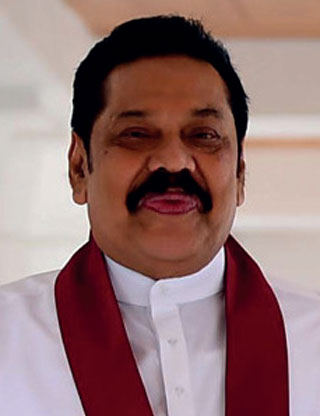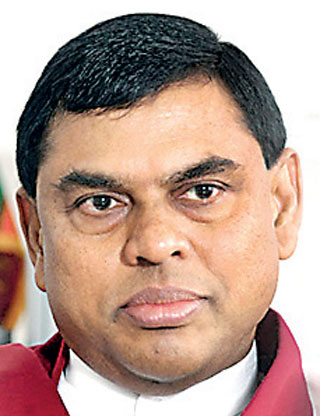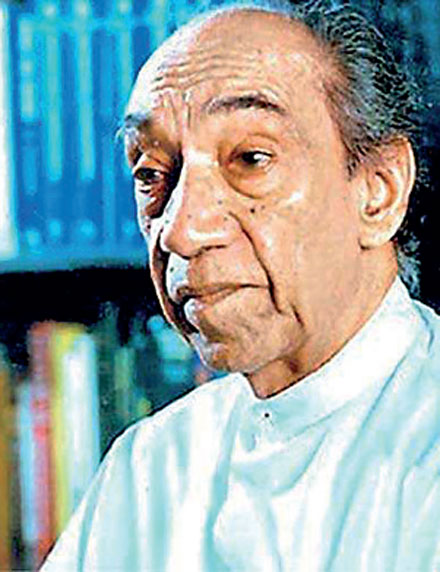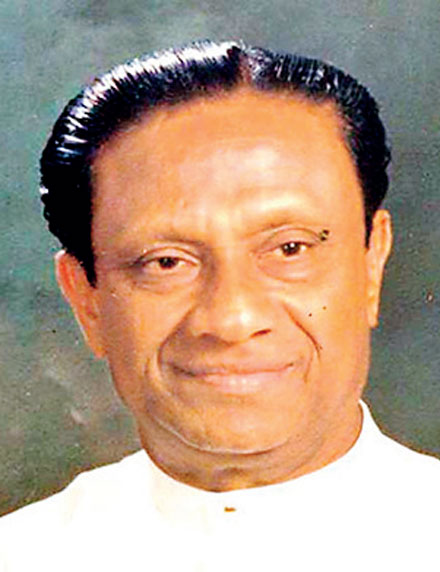Friday Apr 18, 2025
Friday Apr 18, 2025
Thursday, 20 January 2022 00:25 - - {{hitsCtrl.values.hits}}

President Gotabaya Rajapaksa

Prime Minister Mahinda Rajapaksa

Minister of Finance Basil Rajapaksa

J.R. Jayewardene

Ranasinghe Premadasa
|
 Borrowing in wartime to fight a war would have been fine, but most of the borrowing has been post-war. Borrowing from governments for post-war infrastructure-building is fine, one can always negotiate repayment. Borrowing from the private international markets in the post-war period is not.
Borrowing in wartime to fight a war would have been fine, but most of the borrowing has been post-war. Borrowing from governments for post-war infrastructure-building is fine, one can always negotiate repayment. Borrowing from the private international markets in the post-war period is not.
Repaying the private creditors when you don’t seem to have funds to pay for fuel and electricity means you are not putting the people first and have lost the moral right to make decisions about the citizens’ lives.
New war
President GR sounded pretty determined when he announced, in his Parliamentary address (18 Jan), a Cultivation War (Vagaa Sangraamaya) as a priority in 2022. Which army will wage this war, who will plan and lead it, and who will be the field commanders (pun intended)?
Meanwhile, what was that “first ever” leadership symposium for middle-grade military officers all about anyway? “The symposium…on areas of Military Leadership in the Contemporary World with the vision of transforming military leadership to effectively manage contemporary national requirements…” (Daily FT)
Most speakers were from the Kotelawala Defence University’s Faculty of Defence and Strategic Studies. A former Army Chief, and the current head of State Intelligence were also expert participants. None were specialists in Management Studies.
Who decided, when and under which Constitutional provision and legal regulation, on “transforming military leadership to effectively manage contemporary national requirements”? Which “contemporary national requirements” and who decides that they are “requirements” to be handed over to the military for management? Who has a mandate to transfer a purely civilian responsibility of elected legislators and qualified administrators, to the military, thereby altering the basic character of the state? Do the PM and the Cabinet know? Does Parliament?
Pohottuwa and peasants
The SLPP has to decide whether it is going to continue to be dragged by a crocodile into deeper waters. That crocodile is the ensemble of policy (‘organic’), agency (military) and attitude (unscientific, insensitive, obdurate) of the President in the crucial sphere of agriculture, which contains the bulk of the SLPP and SLFP voters.
The peasantry has begun to signal its forthcoming marches for fair compensation. The President and the Army chief have in turn signalled their determination to ‘monitor’ and ‘educate’ the peasantry. You cannot ‘educate’ farmers into something that the soil resists, i.e., something that goes against both science and nature. Nowhere in the world can peasants, the bulk of whom work on individual plots of land, be successfully regimented, least of all by the military.
The President, a Sinhala-Buddhist ultranationalist, will learn something that Mahinda Rajapaksa has known for decades, namely that the Sinhala-Buddhist peasants are a free people, who will resist dictates and jackboots. They are also a very practical people, who are not going to be instructed by the military on a subject that they, as peasants, have known for generations, while the military has not.
The peasantry has provided a war-winning army with its sons as recruits; sons who shed their blood for the country. President Gotabaya Rajapaksa and his recent orders to the military may now push the peasants and their sons and daughters to mobilise to defend and restore their way of life and sources of livelihood.
SLPP and SLFP
A vote base which shifted from the SLFP to the SLPP is more likely to shift back to the SLFP under its most recent national leader/President, not to the ‘ancient regime’ of Chandrika, or to any other, further space.
Some SLFP MPs will cling to their posts especially if this is their last innings, but when the peasant tide becomes manifest, the SLFP will go with it. This is the same grassroots dynamic that made most of its elected representatives at all levels shift from the SLFP to the SLPP.
The ‘Pohottuwa’ was meant as the party for the pro-MR majority of the SLFP; the party that represents the SLFPers who were with MR from Nugegoda February 2015 through the series of Mahinda Sulanga rallies. It was to be MR’s party. That indeed is what it was at its height in 2017 (Galle Face) and February 2018 (the breakthrough victory at the local authorities’ election).
Somewhere in 2018 the Pohottuwa became something else: the party mainly of the two siblings, initially Basil and later Gotabaya. Basil was supposed to be the custodian of the Mahinda-ist version of the Rajapaksa-SLFP ‘progressive’ populist heritage, balancing-off the rightist radicalism of the Gotabaya caucus. Instead, BR and GR moved simultaneously to brick-up MR when they sensed an MR-Sirisena rapprochement in 2018.
Both BR and GR courted or permitted the radical far-right racist elements. The Pohottuwa changed its discourse accordingly. The Mahinda-ist ideological discourse, articulated best and for the longest by Dullas Alahapperuma, began to be overlaid by ultranationalists Channa Jayasumana and Gevindu Cumaratunga. SLPP and Joint Opposition (JO) conclaves were addressed by Gotabaya’s Viyath Maga/Eliya militarist-racist personalities.
Basil Rajapaksa’s current attempts at pragmatism are hamstrung by the extremism that he permitted and channelled. Those hardliners are the bulwark of the President’s hawkish perspective within the party; a perspective that is atomising the social base and electoral viability of the ruling SLPP.
|
Landslide against, not for
The next election will be a reloading of 1977, but only in one dimension: the fate of the ruling party. It will probably not be a 1977 or a 2020 landslide victory for any Opposition party.
Inasmuch as no party is the equivalent of the radically transformed UNP Opposition in 1973-1977 under J.R. Jayewardene and Ranasinghe Premadasa, it is difficult to envisage a parliamentary landslide on the 1977 scale.
J.R. Jayewardene’s choice of Finance Minister to spearhead his economic revolution of ‘opening up’ was Ronnie de Mel. Not an economist, he held a first-class Honours degree from the University of Ceylon. He wasn’t even a UNPer until a few months before the 1977 election. He was a pronouncedly left-leaning SLFPer and an admirer of Cuba which he had visited and of Che Guevara, whom he had met. When Ronnie de Mel quit the ruling SLFP in 1976, his first public lecture was in Jaffna as a guest of N. Sanmugathasan, the Maoist founder-leader of the Ceylon Communist Party.
He also happened to be the best-read in the UNP of 1977 which had a collection of highly intelligent people. In retirement in London, he was a guest of Labour’s Gordon Brown when the latter presented his maiden Budget as the Chancellor of the Exchequer.
Clearly then, in 1977, the election-winning behemoth the UNP had become after its post-1973 renovation, was not the JR plus B.R. Shenoy rightwing – Esmond Wickremesinghe’s ideological project—of the UNP of 1965-1970.
In 1977 the massive vote of Madam Bandaranaike’s 1970 coalition didn’t go to the 1965-1970 UNP which had been vanquished in 1970; it went to the 1973-1977 UNP which had shifted comparatively leftward.
The UNP at its points of peak achievement, the landslide victory of 1977 and the near-miraculous comeback of 1988-91 (when it successively won the Presidential, parliamentary and local authorities elections), had undergone two ideological paradigm-shifts plus profile-resets which made it unrecognisable from the predecessor UNP Establishments.
These shifts were in 1973-1977 and 1988. Both were leftward. Both had one personality in common: R. Premadasa. The shift of 1973-1977 was potentially so radical-democratic that the 1978 presidential system was architected so as to give the PM only “the powers of a peon”, thereby bottling that Premadasist progressive-populism, which however had to be fully uncorked for the UNP to survive and prevail in 1988 in the face of the JVP and SLFP challenges.
In 1988, Ranasinghe Premadasa vaulted over the confines of a discredited UNP and won over SLFP and JVP social constituencies. That was a Presidential election, and there is a distinct probability that his son can do the same in 2024, but what of a Parliamentary election?
The JVP-NPP surge and the SLFP’s stirrings are because the main Opposition party has not yet broken decisively out of the diminished UNP vote-enclave, despite its leader’s example and centre-left social democratic direction. Due to the drag-effect of conservative, centre-right ideological and discursive habits of its Establishment, its left flank is wide open at a time of socioeconomic crisis which tends to radicalise social opinion and lend greater traction to left options than in normal times. The main Opposition must tack leftward.
Populism isn’t the problem
The intelligentsia is confused about populism, erroneously conflates it with nationalism and ‘strongmen’ and identifies it with Gotabaya Rajapaksa. GR’s ruthless agrarian policy proves beyond doubt that he is no populist. He is an ultranationalist-militarist autocrat.
Mahinda Rajapaksa was a patriotic-populist, not only because of his Rajapaksa political heritage but also because he observed and learned from his main political opponent President Premadasa, while positioning himself as counterpoint to his main intra-party/intra-governmental rival President Chandrika Kumaratunga and her cosmopolitan neoliberalism. If Premadasa was the UNP’s SWRD, then Mahinda was the SLFP’s Premadasa.
When Mahinda was on his ‘long march’ (Pada Yatra) against the Premadasa administration, in wartime and at a time of intense political polarisation, the demonstration proceeded not merely unimpeded but with state security provided by presidential instruction. Premadasa squashed suggestions of disruption as S.D. Bandaranaike had undertaken against the UNP march to Kandy in 1957, with the studied observation: “Mahinda is the man who will overthrow the Bandaranaikes’ feudal reign in the SLFP”.
Vijaya Kumaratunga was a ‘Left populist’. Chandrika (CBK) wasn’t. CBK and Ranil Wickremesinghe could be classified as cosmopolitan-elitist neoliberals, which is why Mangala Samaraweera transitioned easily from one to the other.
The only populist Presidents we had were Ranasinghe Premadasa and Mahinda Rajapaksa, electorally the most successful and arguably the most popular in the mass memory even today. The economy achieved the most under them, shattering the neoliberal myth that populism is and has been the main obstacle to economic development.
President Premadasa’s 200 garment factories program had a socially emancipatory content: mandatory minimum wage, free meals and air-conditioned plants, and the rural diffusion of industrialisation which retained enhanced incomes in the countryside. When his Minister of Industries Ranil Wickremesinghe’s speeches revealed an inability to grasp the difference between the Jayewardene-era Free Trade Zone (FTZ) export-led industrialisation model of Upali Wijewardena and Premadasa’s own 200 garment factories project, he promptly pivoted to Ossie Abeygoonesekara, leader of the oppositional Sri Lanka Mahajana Party (SLMP) and presidential candidate of United Socialist Alliance (USA) in 1988. Ossie accompanied Premadasa as the star speaker at every one of the 200 garment factory openings.
Today’s central phenomenon is the avoidable suffering, misery and despair of the people. The philosophy of political leadership we need is not the insensitive, elitist, unilateralist one that holds that democracy does not have to be deliberative and the policy-making process consultative, and that people must be disciplined to swallow the ‘bitter medicine’ the technocrats prescribe.
What then is the most suitable alternative philosophy for contemporary political leadership? Here’s one:
“If I can become the voice of the voiceless millions, and become the main instrument that will take them out of their misery, I will consider that alone as my greatest achievement…I have never gone back on a promise given to the people or left the people in the lurch…The entire nation knows that I will do what I say and honour the promises I give.”
(Ranasinghe Premadasa, Special Sessions of the UNP, 9 October 1988, Sugathadasa Indoor Stadium)
|
System-change or regime-retrenchment?
On a BBC World interview, the Kumar Sangakkara of Lankan economists, Dr. Nishan de Mel, argued that the economic crisis was virtually intractable because the problem resided in “governance”.
Extending that logically, I argue that we should focus on a change in governance, without wasting time on what Karl Marx derided as “recipes for the cookshops of the future”.
Why, for instance, waste time and space advocating the abolition of the executive presidency, which takes a parliamentary two-thirds majority and a referendum, with no such majority obtainable?
SLFP leader ex-President Sirisena said recently that the 20th amendment made for a king, and should be abolished like the 18th, but added that the 19th amendment made for a dysfunctional tripolar system—President, PM and Speaker—with the latter duo acting as if each was the executive President, thereby causing gridlock. He said the 19th amendment should be suitably rectified and re-balanced when restoring.
It takes the President to call a referendum. GR won’t do so on the issue of abolishing the executive presidency. He will have to hold a referendum on a new draft Constitution but that will retain the 20th amendment while trashing the 13th. Whichever way one votes, one retains the 20th amendment. This situation remains until the 2024 presidential election.
The JVP-NPP and the NMSJ advocate the abolition of the Executive Presidency and the retention of Provincial Councils. Given the axiomatic geopolitical realities, this combination is riskily centrifugal.
Even a newly-elected government may lose a referendum – a la Brexit—for dismantling the executive presidency while retaining provincial autonomy, when Tamil politics still calls for “federalism…and self-determination”. Such a referendum could make any post-Rajapaksa government vulnerable to a (Namal) Rajapaksa-led SLPP in Opposition.
The debate about the Independent Commissions is a Gordian Knot to be cut. In the USA, the executive is checked not by commissions consisting of unaccountable NGO members, but by legislative oversight in the form of strong Congressional committees. In Sri Lanka, that would forestall any backlash.
To de-politicise public service appointments, simply return to the situation prior to the abolition of the independent Public Service Commission; opt for restoration of the pre-1972 PSC.
Attributing all contemporary ills to the 1978 Constitution while upholding the parliamentary model and the leaders/authors of the 1972 Constitution as repositories of virtue, is palpably dishonest and hypocritical.
Every single centrifugal, supremacist act that dragged this country from being ahead of the rest of South Asia to lagging behind it, took place under Ceylon’s/Sri Lanka’s Westminster model.
The disenfranchisement of the hill-country Tamils of Indian origins, the Sinhala Only policy, the takeover of private Catholic schools, the policy of district-wise and media-wise standardisation of marks at university entrance, the Constitutional declaration of Sinhala as the sole official language, and conferral of primacy of place for Buddhism, took place under parliamentary democracy (and the nostalgically admired first-past-the-post electoral system).
Not a single such piece of discriminatory legislation was promulgated under the 1978 Constitution (and the system of proportional representation).
The 1958 anti-Tamil riots occurred; the JVP, the Tamil New Tigers (TNT) and its successor the LTTE were formed; separatism became mainstream Tamil politics (Vadukkodai resolution 1976); and armed insurgencies were born--all during the Parliamentary period of our post-Independence history.
A National ‘Democracy Summit’
We need, urgently and imperatively, the Lankan equivalent of Biden’s global Summit for Democracy—a Democracy Summit/Roundtable of political party leaders which identifies the common denominator, commits to it and drafts a Minimum Program for:
(1) Democratic resistance to autocracy, militarisation and socioeconomic ruin, and
(2) A strategy of irresistible, cumulative pressure for regime-retrenchment, oriented towards early political transition, if necessary ruptural.